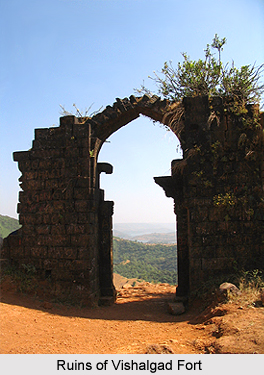 Vishalgad Fort is an ancient hill fortress that is located almost 76 km towards the north west of Kolhapur in the state Indian state of Maharashtra. The fortress is also known as Khilna fort or Khelna fort. It was one of most significant forts of the Maratha Empire during the reign of Chatarapati Shivaji Maharaj. Shivaji captured the fortress and included it in the Maratha kingdom in 1659. Vishalgad Fort was originally occupied by Adil Shahi Dynasty of Bijapur. Later Shivaji and his army attacked the fortress but they failed as it was well defended by the Adil Shahi garrison. Eventually Shivaji again attacked the fort and became successful in capturing it. It was named as Vishalgad by the great Maratha emperor. The structure covers an area of 1130 m (3630 feet). The geographical coordinates of Vishalgad is latitude 16°52`N 73°50`E.
Vishalgad Fort is an ancient hill fortress that is located almost 76 km towards the north west of Kolhapur in the state Indian state of Maharashtra. The fortress is also known as Khilna fort or Khelna fort. It was one of most significant forts of the Maratha Empire during the reign of Chatarapati Shivaji Maharaj. Shivaji captured the fortress and included it in the Maratha kingdom in 1659. Vishalgad Fort was originally occupied by Adil Shahi Dynasty of Bijapur. Later Shivaji and his army attacked the fortress but they failed as it was well defended by the Adil Shahi garrison. Eventually Shivaji again attacked the fort and became successful in capturing it. It was named as Vishalgad by the great Maratha emperor. The structure covers an area of 1130 m (3630 feet). The geographical coordinates of Vishalgad is latitude 16°52`N 73°50`E.
Vishalgad Fort is situated about 60 km towards the north west of Panhala Fort. It is built on the top of a hill in the Sahyadris Mountain Ranges. The hills divide the territory into Anaskura Ghat. It served as an observation tower for to watch out for attacks of the enemy forces for both regions.
History of Vishalgad Fort
Vishalgad Fort was built in 1058 A.C. by the Shilahara ruler Marsinh. Initially it was known as Khilgil fort. It was later seized by the rulers of Seuna Yadavas of Devagiri who defeated the Shilaharas in 1209. King Ramchandra of the Seuna Yadavas was overpowered by Ala-ud-din Khilji in 1309 and the fortress was incorporated into the Khilji Dynasty. It became a part of the Bahmani Sultanate in August 1347 after Hasan Gangu Bahamani, the Mughal chief, became independent. It was also ruled by the Vijayanagar Empire from the year 1354 to 1433.
Shankar Rao More, a local Maratha chieftain occupied the structure after the decline of the Vijayanagar Empire. It was then again captured by the rulers of the Bahamani Sultanate. Eventually Yusuf Adil Shah became independent and established the Adil Shahi sultanate in 1489. The fort also came under his control as he separated along with the area under his rule. Vishalgad Fort was then conquered by Shivaji Maharaj after receiving support from the officers in the fort in 1659.
After the death of Shivaji, it came under the command of Chhatrapati Sambhaji, the eldest son and successor of Shivaji. During his reign, the structure was rebuilt and renovated. Vishalgad was assigned as the capital of almost 90 towns and villages in the districts of Ratnagiri and Kolhapur during the rule of the Maratha kings. The forces of the British East India Company destroyed the entire structure in the year 1844 after a mutiny by the commanding officers or Killedars of Vishalgad Fort.
Architecture of Vishalgad Fort
Vishalgad Fort includes several temples and other buildings inside its premises. However most of these buildings are in a ruined condition at present. Some of the temples are Shri Nrusinha Temple, Amruteshwar Temple and Sati`s Vrindavan. The fortress also includes samadhis dedicated to Phulaji Prabhu Deshpande and Baji Prabhu Deshpande who served valiantly under Chatrapati Shivaji. The tomb or dargah of Hazrat Malik Raihan is also located in the vicinity of Vishalgad Fort.



















